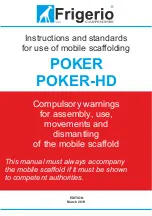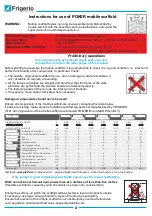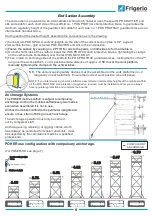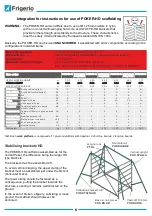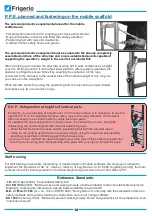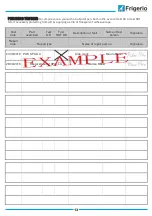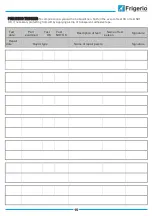
11
ITALIAN LEGISLATION
Legislative Decree No. 81 on 9 April 2008
Art. 111 - Employer obligations for use of work equipment at a height
1. The employer, in the event temporary works at a height cannot be carried out in safe conditions and in adequate ergonomic
conditions starting with a suitable location for the purpose, chooses the equipment most suitable for guaranteeing and
maintaining safe working conditions, in compliance with the following criteria:
a) priority given to collective safety measures over individual safety measures.
b) dimensions of the work equipment suitable for the nature of the work to carry out, the foreseeable stresses and risk-free
circulation.
2. The employer chooses the most suitable type of access system to temporary workplaces at a height based on the frequency
of circulation, the height difference and the duration of use. The access system used must allow evacuation in the event of
imminent danger. Passage from an access system to platforms, scaffolding, walkways and vice versa must not involve
further risks of falling.
3. The employer allows use of a runged ladder in the workplace at a height only if use of other work equipment considered
safer is not justified due to the limited level of risk and the short duration of use, or the existing features of the sites which
cannot be modified.
4. The employer allows use of access and positioning systems using ropes used to directly support the worker, only in
circumstances in which, following risk assessment, the work results as being carried out in safe conditions and use of other
work equipment considered safety is not justified due to the short duration of use and the existing features of the sites which
cannot be modified. The same employer foresees used of a seat fitted with specific accessories based on the outcome of
the risk assessment and, in particular, the duration of the works and the constraints of an ergonomic character.
5. The employer, in relation to the type of work equipment used based on the previous clauses, identifies the measures to
minimise risks for workers, inherent in the equipment in question, including, where necessary, installation of protective
equipment against falling. The aforementioned equipment may present such a configuration and resistance to avoid or stop
falling from workplaces at heights and prevent, as much as possible, any injuries to workers. The collective protective
equipment against falling can only be interrupted in points where runged ladders or rungs are present.
6. The employer, if work of a particular nature is executed requiring temporary elimination of some collective protective
equipment against falling, takes equivalent and effective safety measures. The work is carried out on implementing these
measures. Once this particular work is definitively or temporarily completed, the collective protective equipment against
falling must be restored.
7.
The employer carries out temporary works at a height only if weather conditions do not put workers’ health and safety at risk.
8. The employer forbids consumption and administering of alcoholic and liquor beverages to workers responsible for working at
a height.
Art. 112 - Appropriateness of temporary works
2. Before re-using any type of scaffolding, you must check it to eliminate any parts deemed unsuitable pursuant to Annex XIX.
Art. 123 - Assembly and dismantling of temporary works
1. Assembly and dismantling of temporary works must be carried out under the direct supervision of the works supervisor.
Art. 124 - Storage of scaffolding materials
1. On the service bridges and scaffolding, it is generally forbidden to store any objects, except temporary storage of materials
and equipment necessary for the works.
2. The weight of the materials and the people must always be less than that permitted by the structural strength of the
scaffolding; the space occupied by the materials must allow movements and manoeuvres necessary for work progression.
Art. 126 - Guardrails
1. The scaffolding and service bridges, walkways and ramps placed at a height over 2 metres must be fitted on all sides towards
the open space with a robust guardrail and in good condition.
Art. 128 - Under bridges
1. Scaffolding and service bridges must have safety under bridges, built like the bridge, at a distance of no more than 2.50 m.
2. Construction of the under bridge can be omitted for suspended bridges, for cantilever bridges and when maintenance and
repair works are carried out not lasting more than five days.

